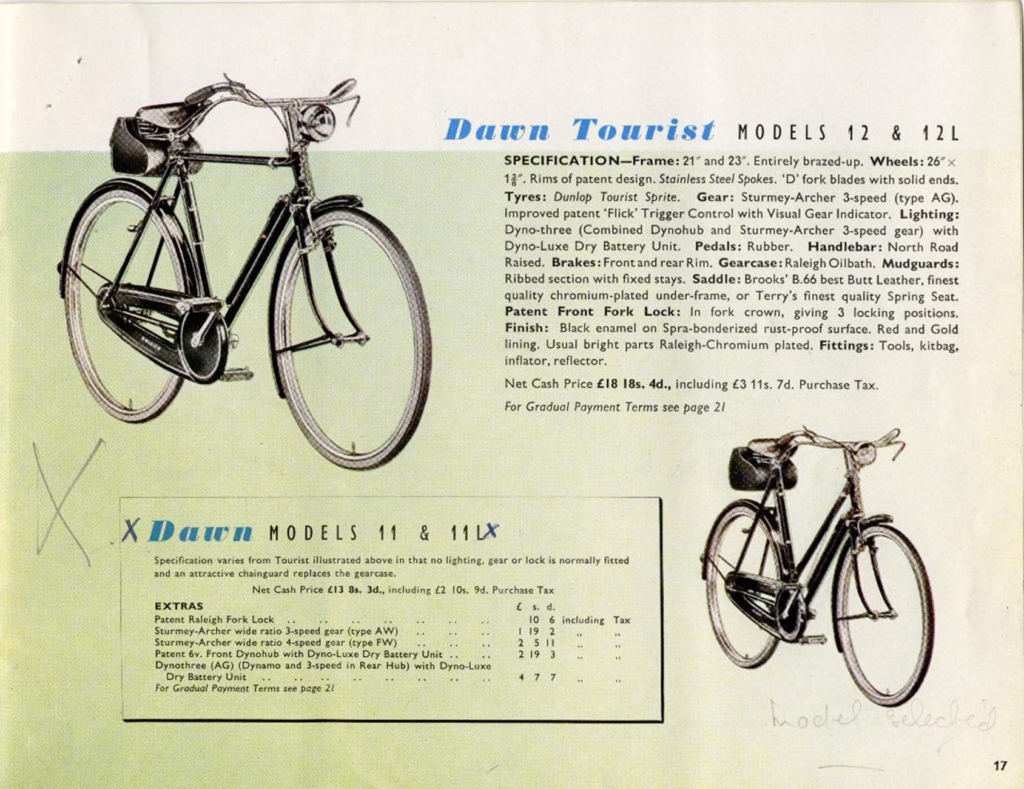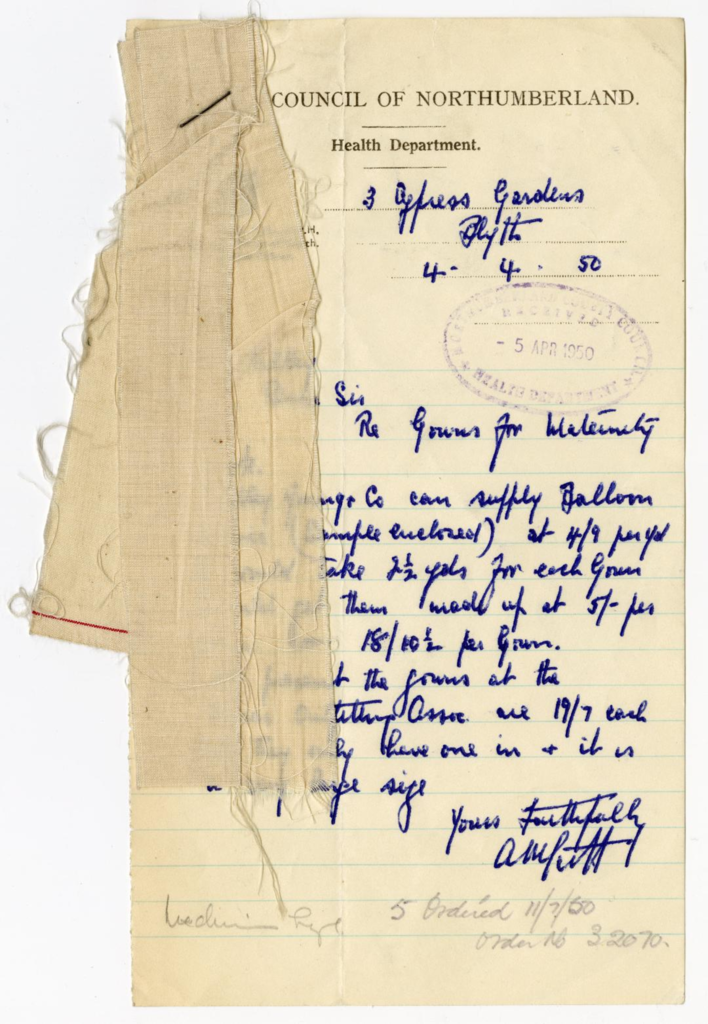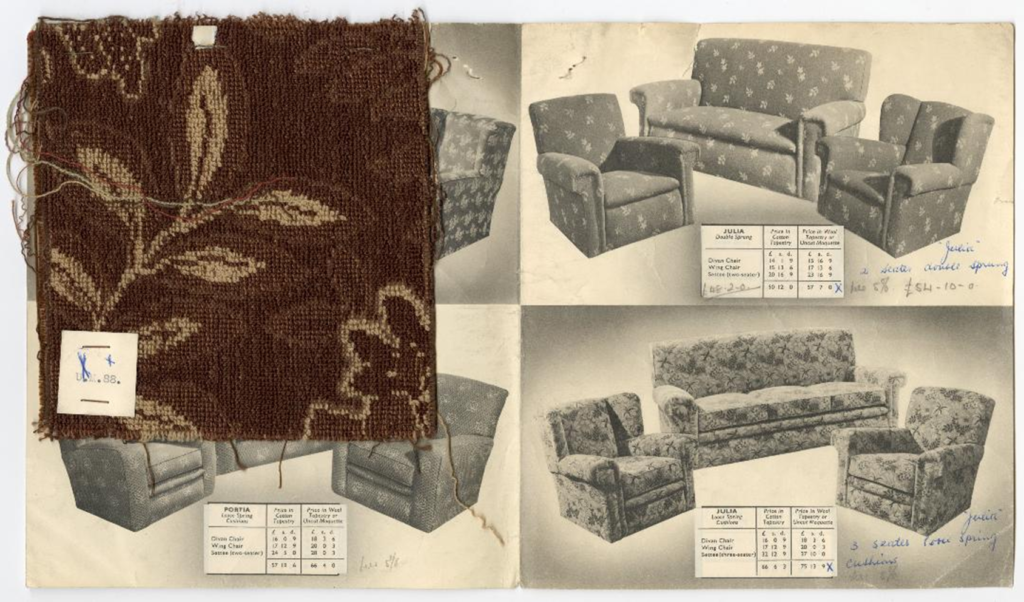This blog has been researched and written by Hilary Love, one of the volunteers on our maternity care project. Project volunteers are researching maternity care in Northumberland with particular focus on Castle Hills Maternity Home, Berwick, and Mona Taylor Maternity Home, Stannington. The blog is based on research that Hilary undertook on one particular file held by Northumberland Archives (ref: CC/CH/NA/1/10). The file forms part of a series of files relating to Nursing Associations. All files prefixed CC/CH/NA/1 relate to Nurses’ Homes in Northumberland. Hilary consulted this file because the catalogue entry suggested that there was content relating to maternity care.
The Nurses’ Home at 3 Cypress Gardens, Blyth, was run by a charity, established in a conveyance dated 18 February 1946.
A letter from Northumberland County Nursing Association to Mrs. Robinson, Honorary Secretary, Blyth and Cowpen District Nursing Association, explained how, at the Conference in June 1947, a resolution was passed accepting the proposals of the Executive Committee for transfer of the nursing services to the County Council in July 1948. Each individual District Nursing Association had to be asked if they agreed to the proposals and, if so, whether they would consent to give, sell or let to the County Council, such properties as would be essential to the County Council. An urgent response was needed so that plans could be formulated and submitted to the Minister of Health. Blyth Nursing Committee were willing to let their Nurses’ Home to the County Council at a rent to be agreed at a later date. The house was owned by the Blyth District Nursing Association and held in trust.
A letter of November 1947 gave agreement to let the house to the County Council at a rental of £3 per week and to sell the furniture to the Authority. An inventory dated 11 December 1947 lists eight cycles – 2 Maples, 2 Phillips, 3 Hercules and 1 “the Special”- all rated ‘Good’ and 13 Midwifery Nursing and General Bags. The County Valuation Officer, in a letter to Dr. Tilley dated 11th December 1947, refers to the property as in a good state of decorative and structural repair, in one of the best residential parts of Blyth.
The formation of the Blyth Care Committee was considered in July 1948. The proposed name was Blyth District Nurses’ Care Committee but the County Maternity and Child Welfare Officer replied on behalf on Dr. Tilley stating that they would prefer that they called themselves Blyth Care Committee as all the other districts were doing.
In 1948, the question of painless midwifery arose. A letter from the Medical Officer of Health, Dr. Newell, Borough of Blyth, to Dr. Tilley, County Medical Officer, queried who administered the Chloral. “Are the midwives being permitted to use Chloral? The Pethidine is, I presume, used by the doctors?” This was forwarded to Miss Scott, Superintendent at the Nurses’ Home, by the Maternity and Child Welfare Officer. Miss Scott’s reply stated that Chloral had not been used in the district at all. Doctors had sometimes administered Pethidine. “Midwives were instructed in the use of Chloral while taking their Gas and Air Course at Newcastle General Hospital but we have not had permission to use it on the district.” Dr Newell’s reply to Dr. Tilley stated that he was particularly concerned about the use of Chloral (the amount) and if midwives were so permitted to use it and whether by the rectum.
Cycles were obviously important items of equipment and Miss Scott wrote to Dr. Tilley about the nurses’ cycles being in poor condition. A catalogue supplied by Sep. Mole & Sons, Cycle Dealers, Havelock Street, Blyth, is in the file. If only the prices applied now! A Lady’s Raleigh, Dawn Model, priced at £13. 4s. 5d, plus a Dyno hub £2. 19s. 3d. and a bell 2s. 9d. came to £16. 16s. 5d.

A note was added to the letter that two bicycles were supplied, one from Stamfordham and one from West Sleekburn.
In 1951, Miss Scott reported the theft of 2 bicycles, one from outside Mr. Fairbairn’s workshop, York Street, and one from outside 69 Second Avenue, when Nurse Kailofer was attending Mrs. Bartlem. The Midwifery bag was also stolen. Miss Scott was instructed to obtain locks for the cycles as soon as possible. A note of 14 February 1951 stated that the bag was recovered with contents intact and the bicycle had been found. Blyth Police reported that no one had been apprehended and it was unlikely that they would do so as gangs of children were responsible for the thefts which had become an epidemic in the Blyth area.
A letter dated 19 July 1954 showed progress in transport when the Health Committee approved the purchase of an A.C. Petite car (a 3 wheeler) for the use of the midwives living in the Nurses’ Home in Blyth. It suggested converting the cycle shed or the aftercare store to a garage. A plan to erect a garage by converting the cycle shed at an estimate of £60 was approved.
There are interesting examples in the file of requests for clothing and sheets, with a sample of material i.e. Balloon Fabric. Mrs. Robinson requested coupons in 1948 for the purchase of sheets. It seems that coupons were not needed for the other items they bought, blankets and rubber sheets. Mrs. Robinson was informed that a certificate was no longer necessary for her request for 150 yards of unbleached cotton for draw sheets and that the material could be obtained from any firm, although it was extremely difficult to obtain at present. Coupons for the other items were supplied in the form of a Coupon Equivalent Document, A.B. 252641 – for 6 coupons- by the County Medical Officer.
In April 1950, gowns for maternity work were ordered. Hedley Young, the Department Store in Blyth, provided a sample, i.e. the Balloon Fabric, at 4/9d (48p) a yard. Two and a half yards for each gown and 5s. (50p) per gown to be made up made a total of 18s 10½d. per gown. Five gowns were ordered from Hedley Young. The Nurses’ Outfitter’s Association were priced at 19s 7d. (98p) each.

In 1950, an order was placed for an “Airborne” Three Piece Suite in uncut moquette, comprising a three seater settee and two easy chairs with spring interior cushions which cost £63.10. 0d. (£63.50). This was actually ordered for the Nurses’ Home in Whitley Bay but is a good example of the type of furniture used in the Nurses’ Homes. It was ordered from Binns Ltd. In Newcastle.

A second demand for payment from the Collector of taxes was forwarded in January 1951 to Blyth Care Committee who were responsible for paying the tax schedule. The demand had been ongoing since June 1949. Dr. Tilley informed Mrs. Robinson in 1952 that, after much correspondence, the Blyth Care Committee had been exempted from Land and Income Tax on the grounds that they were a charitable institution. All the tax since 1948 had been repaid and to celebrate, new curtains and other items had been purchased to add to the comfort of the Nurses’ Home.
Dr. Tilley forcefully expressed his opinion of the tax collectors: “The Commissioners for Income Tax are usually so assiduous in squeezing money out of the average citizen that it is delightful to hear of them deciding to let you off in future and pay back the money that they have wrongfully taken from you since 1948.”
Part-time staff were reduced in June 1952 as a result of a steady decline in the number of domiciliary midwifery bookings in the Blyth District. It was decided to place the nurses formerly engaged as full time midwives on combined duties and dispense with the services of the two – part time general emergency relief nurses. The arrangement had the full approval of the Superintendent at the Home and of the midwives concerned. The emergency relief nurses were given adequate notice.
Mrs. Robinson, Honorary Secretary of Blyth Care Committee, wrote, in January 1954, requesting that members of the Committee meet with the Chairman of the Health Committee to discuss the plan to use some of their funds to commemorate Coronation Year.
A letter from the Area Executive Medical Officer, Mr. Donaldson, to Dr. Tilley, County Medical Officer, outlines their plans to subscribe in the region of £3,000 for the provision of a ward at the Thomas Taylor Homes. A meeting was set up with Alderman Garrow, the Chairman of the Health Committee. There was no information in the file to record whether the ward was provided or not.
A letter from the County Medical Officer to D. W. Foster, Borough Engineer for Blyth Corporation, requested a street plan for all the new housing estates in Blyth, for the use of the District Nurses and Midwives. A 1/2500th plan of Cowpen Neighbourhood is attached to the letter which gives an interesting insight into the development of Blyth on quite a massive scale. All the other Housing schemes were already incorporated in the Town Guide Plan.
A letter from Dr. Tilley, County Medical Officer, to the Health Department of the County Council, stated that, from 1st April 1957, the Nurses’ Home would not be occupied by the nursing staff who would be living and working from their own homes in Blyth, i.e. two District Midwives, Nurse J. Solan and Nurse R. McArthur and two General Nurses, Nurse M. I. Bellwood and Nurse E. Dunn. The position was reviewed in March by the Health Committee as the Senior Nurse in charge of the Nurses’ Home was due to retire and it was increasingly difficult to obtain resident nursing staff. The Committee decided that it was no longer economical or practicable to continue using the Nurses’ Home. Miss Scott agreed to stay until telephones were installed at the nurses’ home addresses but only to receive and allocate calls for the midwives and nurses.
On the 6 November, 1959, a letter to the Rating Officer from the Health Department confirmed that 3, Cypress Gardens was now rented and furnished by the Regional Hospital Board who took over the property from the County Council on 1st November 1958. An article in the Blyth News, 4th February 1960, reports on the sum of £1.413 left to be shared between the local hospital and Blyth and District Nurses’ Home. It explains that the Home no longer exists as it was incorporated with the Beulah House Maternity Home, managed by the Wansbeck Hospital Board.
A letter dated 24 March 1960 refers to the bequest made by the late Miss Edith Keenleyside, who died in 1958, to the local hospital in Blyth and to the Blyth Nurses’ Home, for the purpose of providing comforts for the district nursing staff. A letter to Dr. Tilley from the Clerk of the County Council re. the bequest states that there may be difficulty in claiming it as there is no nurses’ home in Blyth. He asks for further information before taking up the matter with the London solicitors. As the Blyth & District Nursing Association had been superceded by the Blyth Care Committee, he wished to know if its activities were limited to the Blyth District or to the area and if they extended to providing extra comforts to the nurses in the area. Depending on the objects of the Care Committee, it may be worth pursuing the claim.
A copy of the Charity Commission’s document relating to the Care Committee, now known as Blyth Care Charity, is attached to the letter.
Another letter dated 21 April 1960 to Mr. Harvey, Clerk of the County Council, stated that there was no point in making an application to the High Court at the present time. This was the final document in the file so the outcome is not recorded.
